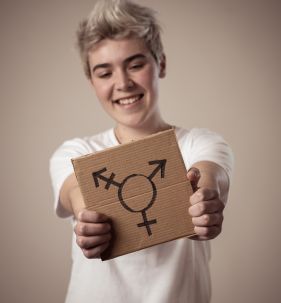For too long, transgender individuals have been shrouded in myths and misconceptions, but it's time to unveil the truth and understanding behind gender identity.
- What Does Transgender Mean?
- History of Transgender Individuals
- How Prevalent Are Transgender People?
- Transgenders and Pronouns
- How Is Sexual Orientation Different from Gender Identity?
- How Is Gender Identity Different from Gender Expression?
- How Do Transgender Individuals Make a Gender Transition?
- What Should Parents Do if Their Child Appears to Be Transgender or Gender Nonconforming?
- Common Misconceptions about Transgenders
- Challenges Faced by Transgender Individuals
- Why Is Transgender Equality Important?
- The Bottomline
Transgender individuals are people whose gender identity does not match the sex assigned to them at birth. This group includes those who identify strictly as male or female and those who identify as neither, often leading to medical changes.
Visibility and support for transgender rights have grown significantly in recent years. Through major court decisions and legislation, transgender people in the U.S. have gained crucial legal rights.
Despite these advances, discrimination remains a serious problem that transgender individuals face. This article provides an easy-to-understand overview of what being transgender means, their history, and the difficulties they continue to face today. It also outlines ways individuals and society can help support and affirm transgender people.
What Does Transgender Mean?
Transgender is a term used to describe people whose gender identity or expression differs from the gender they were assigned at birth.
It is an umbrella term encompassing many gender identities and expressions.
Some transgender people identify as male, some as female, and others as non-binary or genderqueer.
Non-binary or genderqueer individuals do not identify as exclusively male or female and may express their gender in various ways outside traditional male/female norms.It's important to note that being transgender is not a mental disorder but rather a part of the natural human variation.
Transgender people face significant societal challenges due to stigma, discrimination, and lack of understanding. They may experience gender dysphoria, discomfort or distress caused by the mismatch between their gender identity and assigned gender.
Many transgender people choose to transition, which can involve medical interventions, such as hormone therapy and surgery, as well as social and legal changes to their name, gender marker, and other personal information. It's important to respect and support transgender individuals and their identities and recognize their right to live authentically.
History of Transgender Individuals
The history of transgender individuals and communities is long and varied, but it has often been overlooked or erased by dominant cultural narratives.
Transgender people have existed throughout history and across cultures, but their experiences and identities have been shaped by the social, cultural, and political contexts in which they live.
Here are a few examples of transgender history:
Ancient cultures, such as the Hijra in South Asia, recognized and valued gender-nonconforming people and created social roles for them. Hijra is considered a "third gender" and has a long religious and cultural significance history in the region.
In Europe during the Middle Ages, there were cases of individuals assigned females at birth who dressed as men and lived as men. Some of these individuals could pass as men and even marry women. However, these individuals were often discovered and punished, and their stories have been largely erased from history.
In the United States, the 20th century saw the emergence of transgender communities and activism. In the 1950s and 1960s, transgender people began to organize and advocate for their rights, often in the context of broader LGBTQ+ activism. Transgender people played a significant role in the Stonewall riots of 1969, widely considered the birth of the modern LGBTQ+ rights movement.
In recent years, transgender visibility and acceptance have increased worldwide, but discrimination and violence against transgender people remain significant issues. Transgender people continue to face barriers to healthcare, employment, housing, and other basic rights, and their experiences and identities are often misrepresented or erased in media and cultural narratives.
Overall, the history of transgender individuals and communities is complex and diverse, shaped by a wide range of cultural, social, and political factors. It is important to acknowledge and celebrate the contributions of transgender people throughout history while also working to address the ongoing challenges and injustices they face today.
How Prevalent Are Transgender People?
It is difficult to determine the exact prevalence of transgender people, as many do not disclose their transgender identity due to fear of discrimination or violence.
However, studies suggest that transgender individuals comprise approximately 0.6% of the US population, translating to about 1.4 million people. This number may be higher in other countries where transgender identities are more accepted.
It's important to note that the actual number may be higher than this estimate. Many individuals may not feel comfortable disclosing their transgender identity in surveys or other research studies.
Transgenders and Pronouns
When referring to a transgender person, using the name and pronoun they prefer is important. For example, if a transgender person has told you that they prefer to be called by a certain name and referred to using a specific set of pronouns, it's important to respect their wishes and use those names and pronouns when referring to them.
If you're unsure of a person's preferred name or pronouns, the best thing to do is to ask them politely and respectfully. For example, "I want to make sure I use the name and pronouns that feel most comfortable for you. What name and pronouns should I use when referring to you?"
Using a person's preferred name and pronouns is important in respecting their gender identity and showing them that you accept and support them. It may take some time to adjust to using new names and pronouns, but it's a crucial part of being an ally to transgender people.
How Is Sexual Orientation Different from Gender Identity?
Sexual orientation and gender identity are two distinct concepts that are often confused. Sexual orientation refers to an individual's emotional, romantic, and physical attraction to others.
It can be classified into different categories, including heterosexual (attraction to the opposite gender), homosexual (attraction to the same gender), bisexual (attraction to both genders), asexual (no sexual attraction to either gender), and others.
On the other hand, gender identity refers to an individual's internal sense of their gender. It is not necessarily tied to one's biological sex or the gender assigned to them at birth.
Gender identity can be classified into different categories, including cisgender (one's gender identity matches the gender assigned at birth), transgender (one's gender identity is different from the gender assigned at birth), genderqueer (one's gender identity is non-binary or outside of the traditional binary of male/female), and others.
How Is Gender Identity Different from Gender Expression?
Gender identity and gender expression are two different concepts, although they are often related.
Gender identity refers to a person's internal sense of their gender. It is the gender a person identifies as, whether male, female, nonbinary, or any other gender identity. Gender identity is not necessarily tied to the sex assigned at birth or physical characteristics.
Gender expression, on the other hand, refers to the way a person presents their gender to the world through clothing, behavior, and other outward expressions. It can include things like clothing, hairstyles, and mannerisms.
Gender expression can be related to gender identity, but it is different. A person may express their gender in ways that are different from societal expectations for their gender or in a way that doesn't align with their assigned sex at birth.
To put it simply, gender identity is who you are, while gender expression is how you choose to express that identity to the world. It's important to recognize that each person's gender identity and expression are valid and should be respected.
How Do Transgender Individuals Make a Gender Transition?
The process of gender transition for transgender individuals can vary widely depending on the individual's needs, preferences, and access to resources.
However, here are some common steps that transgender individuals may take to transition:
Social transition
Many transgender individuals start by socially transitioning, which involves changing their name, pronouns, and presentation to align with their gender identity. This may include changing their hairstyle, clothing, and mannerisms and informing family, friends, and coworkers of their gender identity.
Hormone therapy
Hormone therapy, also known as hormone replacement therapy (HRT), can change the body's physical characteristics to align with the individual's gender identity. For example, a transgender woman may take estrogen to develop breasts and decrease body hair growth. In contrast, a transgender man may take testosterone to deepen their voice and increase muscle mass.
Surgery
Some transgender individuals may undergo surgery further to align their physical characteristics with their gender identity. Gender-affirming surgeries can include top surgery (breast augmentation or reduction), bottom surgery (genital reconstruction), and facial feminization or masculinization surgeries.
Legal changes
Transgender individuals may need to update legal documents such as their driver's license, passport, and birth certificate to reflect their gender identity. This process can vary depending on the laws in their country or state.
It's important to note that not all transgender individuals choose to or have access to these options. Each person's gender transition is unique and should be respected. Some individuals may choose not to undergo medical interventions or surgery, while others may be unable to due to financial, cultural, or other reasons. It's important to support transgender individuals in their transition and respect their autonomy in making decisions about their bodies and identities.
What Should Parents Do if Their Child Appears to Be Transgender or Gender Nonconforming?
If a child appears to be transgender or gender nonconforming, parents need to provide love and support. Here are some steps parents can take:
Listen to your child
If your child expresses that they are transgender or gender nonconforming, listening to them without judgement is important. Let them share their thoughts and feelings, and ask questions if you need to understand better. Remember, your child's gender identity is valid and deserving of respect.
Educate yourself
Learning more about gender identity and expression can help parents better understand their child's experience and provide support. Seek resources like books, websites, and support groups for parents of transgender and gender-nonconforming children.
Advocate for your child
Parents can play a crucial role in advocating for their child's rights and ensuring they are treated with respect and dignity. This may include advocating for inclusive policies at their child's school or accessing gender-affirming healthcare.
Seek professional support
Working with a therapist or counselor who is knowledgeable about gender identity can be helpful for both parents and children. They can support and guide you in navigating the challenges that may arise during the transition process.
Provide a safe and supportive environment
Creating a safe and supportive home environment is crucial for transgender and gender-nonconforming children. This may include using their preferred name and pronouns, allowing them to express their gender in an authentic way, and protecting them from discrimination and bullying.
Ultimately, the most important thing parents can do is to love and support their child unconditionally. By doing so, parents can help their children feel affirmed and empowered to live authentically.
Common Misconceptions about Transgenders
There are many common misconceptions about transgender individuals that can contribute to stigma and discrimination. Some of these misconceptions include the following:
Being transgender is a mental disorder: This is not true. Being transgender is not a mental illness, although some transgender individuals may experience mental health challenges related to the stress of living in a society that is often not accepting of their gender identity.
Transgender individuals are just confused or going through a phase: This is a harmful stereotype that does not reflect the reality of the transgender experience. Transgender individuals often report feeling a strong and consistent internal sense of gender that may not align with the sex they were assigned at birth.
Being transgender is a choice: This is also a harmful stereotype that does not reflect the reality of the transgender experience. Gender identity is a fundamental aspect of a person's sense of self, and individuals do not choose their gender identity more than their biological sex.
Transgender individuals are all the same: This is not true. Transgender individuals come from all walks of life and have various experiences, identities, and expressions.
Transgender individuals are a threat to others: This harmful stereotype contributes to discrimination and violence against transgender individuals. In reality, transgender individuals are more likely to be victims of violence than perpetrators.
Challenges Faced by Transgender Individuals
Transgender individuals face challenges that can make it difficult to participate in society and live with dignity and respectfully. Some of the challenges that transgender individuals may face include the following:
Discrimination and violence
Transgender individuals are at high risk of experiencing discrimination and violence in their personal lives and in broader society. This can include employment and housing discrimination, hate crimes, and violence.
Lack of legal protection and recognition
Transgender individuals often face legal barriers that make it difficult to access the resources and services they need.
Issues with identification documents
Many transgender individuals face challenges obtaining documents that accurately reflect their gender identity. This can make it difficult for them to access various services, including healthcare, housing, and employment.
Legal barriers to healthcare access
Some transgender individuals face legal barriers that make it difficult to access appropriate healthcare, including hormone therapy and gender-affirming surgery.
Mental health issues
Transgender individuals are at increased risk of experiencing mental health challenges, including depression, anxiety, and suicidal ideation.
Why Is Transgender Equality Important?
Transgender equality is important for several reasons. Firstly, it is a matter of human rights. Transgender individuals have the same right to dignity, respect, and freedom from discrimination.
Denying transgender people equal treatment under the law—or the ability to access healthcare, education, housing, and employment opportunities—violates their basic human rights.
Secondly, transgender equality is critical for improving public health and well-being. Transgender individuals face significant health disparities, including higher rates of depression, anxiety, and suicide. Discrimination and stigma also make it more difficult for transgender people to access healthcare, leading to lower rates of preventive care and higher rates of chronic illnesses.
Thirdly, transgender equality is important for creating a more just and inclusive society. A society that respects and celebrates diversity is stronger and more vibrant. By promoting transgender equality, we can build a society that values and embraces all individuals, regardless of gender identity.
In short, transgender equality is important for promoting human rights, improving public health, and building a more just and inclusive society.
The Bottomline
In conclusion, understanding transgender people is an important step in creating a more just and equitable society. Transgender individuals have long been subject to myths, misconceptions, discrimination, and violence; but greater awareness and education can help break down these barriers.
By learning about gender identity and expression, challenging harmful stereotypes, and advocating for transgender rights, we can create a world where all individuals can live authentically. It is essential to approach conversations about transgender issues with openness, empathy, and a willingness to listen and learn. Together, we can create a more inclusive and accepting world for transgender people and all members of the LGBTQ+ community.
Personalized Recommendation

Get your personalized recommendation
Get more info...











